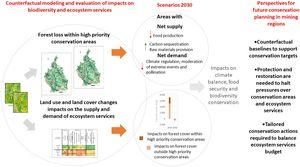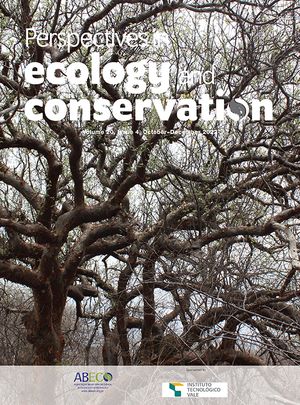The Impact Factor measures the average number of citations received in a particular year by papers published in the journal during the two preceding years.
© Clarivate Analytics, Journal Citation Reports 2025
- •
Combining visual, vocal and sign allow to survey all region’s important game species.
- •
Data collected by local hunters proved efficient for detecting the species composition.
- •
Sightings/vocalisations are crucial to monitor primates and terrestrial game birds.
- •
Tapir and deer can be well monitored using camera trap and track and sign surveys.
- •
Camera traps are the most effective method to record carnivores.
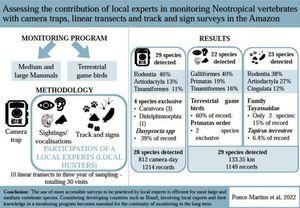
- •
Edges are hotspots of forest cover change in an Atlantic Forest landscape.
- •
Main determinants of both deforestation and regrowth were biophysical factors.
- •
Strictly Protected Areas was the unique socioeconomic determinant of deforestation.
- •
Biophysical determinants may indicate socioeconomic processes involved in forest cover changes.

- •
Grassland ant community composition and body size do not change with fire.
- •
Ant richness increased 1 and 12 months post-fire.
- •
Ant richness was positively driven by plant richness in burned patches.
- •
Seed removal by ants increased 1 month post-fire.

- •
Private Legal Reserves (LRs) can retain part of the alpha and beta diversity
- •
There are a strong turnover of species between LRs and soybean crops
- •
The composition of ants differs among Cerrado, Amazon and transitional vegetation
- •
The similarity among samples decay with geographic distance (300 km) only in LRs
- •
Cerrado LRs shares more species with crops than LRs in any other landscape
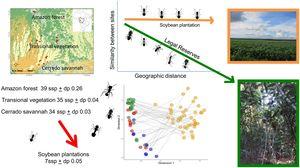
- •
Spatial knowledge of Atlantic Forest primates has biases that vary according to the study scale and grid cell resolution;
- •
In broad-scale perspectives (regional and global) the primate’s spatial knowledge is unbiased;
- •
At narrow-scale perspectives, the knowledge may have bias, depending on grid cell resolution;
- •
The central region of the Atlantic Forest is well sampled;
- •
The São Francisco region and ecotone zones need to be further sampled.

- •
The literature other than scientific journals (non-journals) is a rarely explored resource in predator conservation.
- •
Non-journals are important for some predator species and countries.
- •
The use of non-journals should become a habitual practice to seek solutions for mitigation of human-predator conflicts.
- •
The list of publications and online resources with valuable non-journals is provided.

- •
Raptor species richness increased in tropical cities.
- •
Raptor species richness increased with increasing urban green area size.
- •
Raptor body size increased with increasing urban green area size.
- •
Urban green space size is fundamental for the conservation of raptor communities.

- •
The use of species richness and range size is useful to identify priority regions for the conservation of phyllostomid bats.
- •
The richness-rarity hotspot covered most of the Andean region and up to Panama, with a greater portion in Colombia.
- •
The poorness-rarity hotspot was located in North America, with a major portion in the arid region of Mexico.
- •
Richness-rarity hotspot has a greater proportion of Conservation Units and a greater number of DD species.
- •
In the poorness-rarity hotspot, the conservation of phyllostomid species is at risk due to the lack of Conservation Units.
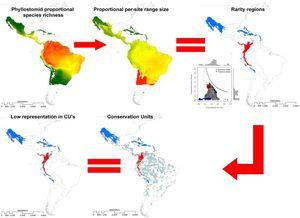
- •
Taxonomic, functional, and phylogenetic diversity comprise multidimensional diversity.
- •
Multidimensional diversity patterns can be mapped to detect conservation priorities.
- •
Protected areas do not always include sites with high multidimensional biodiversity.
- •
Indigenous communities have a fundamental role in the conservation of biodiversity.
- •
Areas with high multidimensional diversity may have high or low ecological integrity.
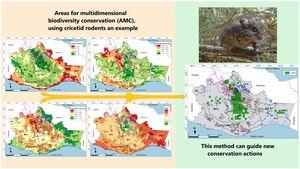
- •
Jaguar densities ranged from 0.44 to 1.6 individuals/100 km2.
- •
Density was significantly lower in more deforested sites vs. less deforested sites.
- •
Landscape resistance for jaguars increased by ∼12% per 10% loss of forest.
- •
More jaguar research in working landscapes is needed to understand land use effects.
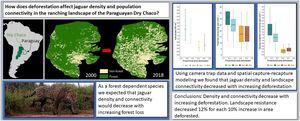
- •
We assess the effect of forest loss on bird diversity in the whole landscape mosaic.
- •
Forest loss decreased forest-specialist and habitat-generalist bird diversity.
- •
Forest loss restricted forest birds to a few sites in the landscape.
- •
Preserving forest cover is paramount for bird diversity in anthropogenic landscapes.
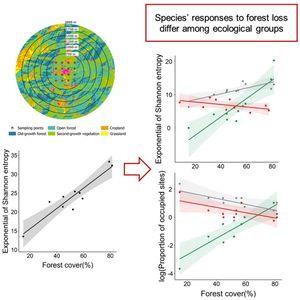
- •
We examined the activity and sonotypes of aerial insectivorous bats present in a human-modified landscape in Southeast Brazil.
- •
Bats exhibited reduced activity and richness in Eucalyptus plantations.
- •
Forest canopy density had a negative effect on overall activity and sonotypes richness of aerial insectivorous bats.
- •
This study reinforce the importance of maintaining preserved areas of native vegetation in agropastoral landscapes.
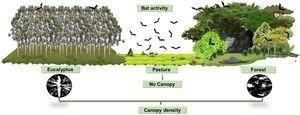
- •
Mining triggered cumulative impacts in a biodiverse region in Brazil’s Atlantic Forest.
- •
Raw materials and carbon sequestration are the least impacted ecosystem services.
- •
Pollination and freshwater provision are the most impacted ecosystem services.
- •
Biodiverse areas would be less impacted in future in contrast to areas with net demand for ecosystem services.
- •
Tailored conservation actions are needed to balance ecosystem services budget.
